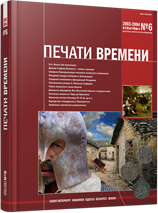Украшения головных уборов XIII-XVI вв. в Карпато-Дунайском регионе
Decorations on Head-Dresses of 13-16 cc. in the Carpathian-Danube Region
Author(s): Svetlana S. RyabtsevaSubject(s): History, Archaeology, Visual Arts, Middle Ages, Modern Age, 13th to 14th Centuries, 15th Century, 16th Century
Published by: Издательский дом Stratum, Университет «Высшая антропологическая школа»
Summary/Abstract: The article is dedicated to the most significant head-dress decorations typical of the population in the Carpathian-Danube Region in 13-17 cc. There are several main traditions in the jewelry art of the time. The Byzantine tradition was still one of the brightest. The Byzantine prototypes served as sources for specific variations of kolts and bead decorations, typical of the jewelry dress in the region. Another tradition surviving till 16 c. was wearing signet-rings, which may be characterized as a common Slavic one. Besides, some decorations are distinguished that find analogues in the Ancient Rus’ (some specific versions of plaques for head-dresses, kolts, bead decorations). As for the diadems, these items reveal Byzantine, West-European and Old Russian parallels. In late 13-14 cc. the head-dresses in the said region acquire decorations of the Golden Horde type (ear-rings shaped as “question mark”, rings with dragon head, ear-rings with teardrop-shaped pendants). Starting with 15 c., items of Turkish fashion were actively borrowed.
Journal: Stratum plus. Археология и культурная антропология
- Issue Year: 2004
- Issue No: 6
- Page Range: 453-472
- Page Count: 20
- Language: Russian
- Content File-PDF

